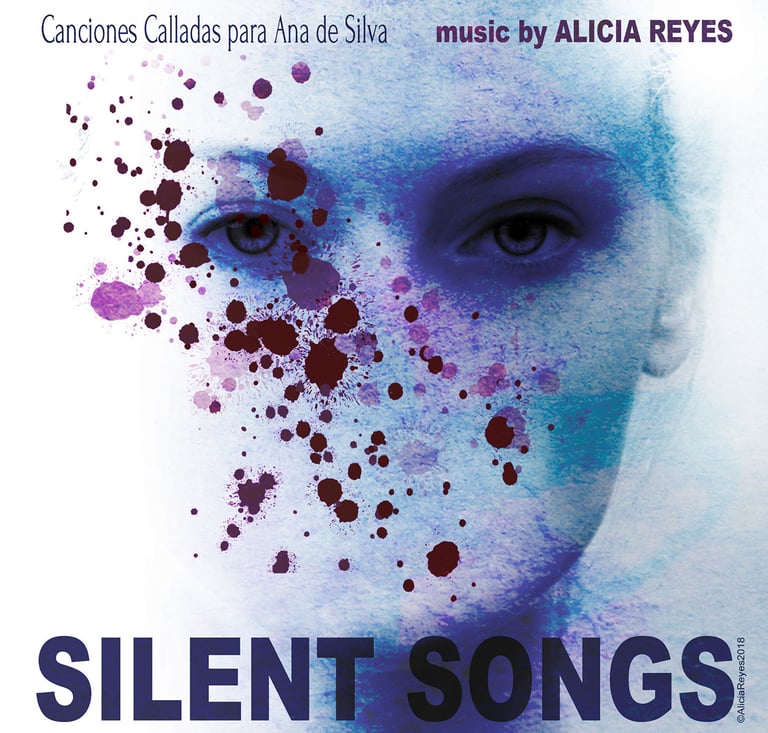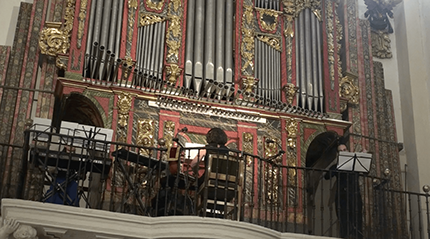Silent Songs (Canciones calladas)
Silent Songs represent the emotions inside Ana de Silva, youngest daughter of the Eboli Princess, imprisoned with her mother at the age of 8.
… y aquí, en este mi pequeño mundo de muros de piedra, aguardo el momento de acariciar la brisa a través de la reja. Hago entonces mía la vida de los que veo allá abajo. Luego, tras la hora de soñar despierta con vidas que no me pertenecen, cierro los ojos y sueño, sueño…
Sueño con la lluvia acariciando mi rostro, sueño con las estrellas, con la sombra de los árboles, con el viento. Sueño y espero, espero…
Tan sólo espero y… sueño.


... and here, in this little world of stone walls, I await for the moment to caress the breeze through the gate. I make mine the life of those who I see down there. Then, after the time of daydreaming with lives that do not belong to me, I close my eyes and dream, dream...
I dream of the rain caressing my face, I dream of the stars, of the shadow under the trees, of the wind. I dream and I hope, hope ...
I just hope and ... dream.
Composición musical para órgano, violín, teclados y electrónica, alrededor de Ana de Silva, hija más joven de la Princesa de Eboli, encarcelada junto a su madre en el Palacio Ducal de Pastrana a la edad de 8 años.
La composición fue estrenada en el XVII Festival Ducal de la Villa de Pastrana, España, el 13 de julio de 2018, e interpretada por la autora, tocando un órgano de 1700, Carlos Cámara al violín y Paola Mitrovic a los teclados.
Premiere
Music composition for organ, violin, keyboards and electronics, about Ana de Silva, youngest daughter of the Eboli Princess, imprisoned with her mother in the Ducal Palace of Pastrana at the age of 8.
The composition was premiered in the XVII Festival Ducal of Pastrana, Spain, the 13th July, 2018. It was performad by the composer playing the Colegiata seventeenth century organ, Carlos Cámara (violín) and Paola Mitrovic (keyboards).


SILENT SONGS for ANA de Silva and Mendoza, a unique name for two very different circumstances.
Through the musical work SILENT SONGS, the composer narrates what could have been for a girl of eight years the imprisonment with her mother in the Ducal Palace of Pastrana during 11 years. The time that would pass slowly waiting for the long-desired moment to admire the Plaza de la Hora without surely understanding the reason why she did not scamper like the rest of the children, nor felt the wind on her face, nor chatted happily as she saw the others down there.
Counting on the submission that is supposed in the ladies of that time and much more even in children, the music shows us a completely current vision of what, from the point of view of the composer, would be the resigned feelings and emotions that would inhabit the inside of that child's mind.
Loaded with symbolism, the work contains representations such as the violin that symbolizes the deepest and innermost feeling,
the piano, the tears
the voice the silent shout to the outside
the organ acts as a narrator.
The work is divided into 4 sections: dreams, by way of scenes.
Dream 1: the confinement
Dream 2: The Square of the hour
Dream 3: Internal conflict
Dream 4: Let me dream
The silent pieces are mixed with others that show the universe on the other side of the palace's gate, as a representation of the two worlds and the two Anas.
Throughout the work we find completely original pieces and others based on works of the Renaissance that have been recomposed adapting them to the medium of interpretation. The music has been written using Renaissance techniques from a current point of view that make this work an approach between the music of the XVIth century and the post-minimal of the 21st.
CANCIONES CALLADAS para ANA de Silva y Mendoza, un único nombre para dos circunstancias bien distintas.
A través de la obra musical CANCIONES CALLADAS, la autora narra lo que pudo suponer para una niña de ocho años el encierro junto a su madre en el Palacio Ducal de Pastrana. El tiempo que transcurriría lento esperando el ansiado momento de admirar la Plaza de la Hora sin llegar seguramente a comprender la razón por la que ella no correteaba como el resto de los niños, ni sentía el viento en su cara, ni charlaba alegremente como veía hacían los demás allá abajo.
Contando con la sumisión que se supone en las damas de aquella época y mucho más incluso en las niños, la música nos muestra una visión completamente actual de lo que, desde el punto de vista de la compositora, serían los sentimientos y emociones resignadas que habitarían en el interior de aquella mente infantil.
Cargada de simbolismos, la obra encierra representaciones como es el caso del violín que simboliza el sentimiento más profundo e interior
el piano, las lágrimas
la voz el grito callado hacia el exterior
el órgano actúa como narrador.
La obra se divide en 4 secciones: los sueños, a modo de escenas.
Sueño 1: el encierro
Sueño 2: La Plaza de la hora
Sueño 3: Conflicto interior
Sueño 4: Dejadme soñar
A lo largo de los sueños, las piezas calladas se mezclan con otras que muestran el universo al otro lado de la reja del Palacio, como una representación de los dos mundos y de las dos Anas.
A lo largo de la obra encontramos piezas completamente originales y otras basadas en obras del Renacimiento que han sido recompuestas adaptándolas al medio de interpretación. El conjunto de la obra se ha escrito utilizando técnicas propias del renacimiento desde un punto de vista actual, tanto en el uso de instrumentos y técnicas sonoras del siglo XX, como en las técnicas compositivas que hacen de esta obra una aproximación entre la música del Renacimiento y el post-minimalimo del siglo XXI.


